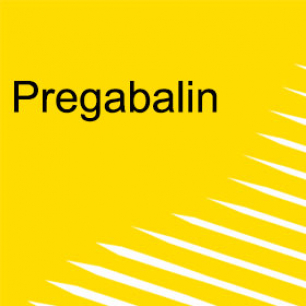Pregabalin
Lyrica®
What is pregabalin?
Pregabalin is a gamma‐aminobutyric acid (GABA) analogue that has pain relief (analgesic) and anti-convulsant effects.
It is prescribed for neuropathic (nerve) pain, epilepsy and anxiety (Cairns et.al, 2017).
It was registered in Australia in 2005 as a Schedule 4 (prescription only) medicine for treatment of neuropathic pain and epilepsy; listed for subsidy on the Pharmaceutical Benefits Scheme in 2013 for neuropathic pain; and in 2016-2017 was the sixth most prescribed subsidised drug in Australia (Sutherland et.al, 2020).
There is growing evidence of the use of non-prescribed pregabalin (Sutherland et.al, 2020).
What are the effects?
Pregabalin slows down impulses in the brain that cause seizures and also affects chemicals in the brain that send pain signals across the nervous system (Cerner Multum, Inc. 2018).
There are a range of reasons why people may use pregabalin for non-prescribed use, including euphoric and dissociative effects.
Side effects may include:
- Severe allergic reactions
- Chest pain
- Confusion
- Irregular and/or increased heart rate
- Fever, chills
- Inability to control urination
- Loss of coordination
- Memory loss
- Mental or mood changes (anxiety, depression, restlessness, irritability, panic attacks, feeling “high”, behaviour changes, suicidal thoughts or attempts)
- Seizures
- Shortness of breath
- Speaking problems
- Weight gain
- Tremors
- Trouble sleeping
- Trouble walking
- Unusual bruising or bleeding
- Tiredness or weakness
- Vision changes (Vardanyan & Hruby, 2016)
What are the risks?
If used as prescribed and recommended, pregabalin is an effective medication.
However, there are risks, particularly if not used as prescribed.
The risks of using pregabalin include:
- Dependence
- Overdose, especially if the person also drinks alcohol, takes other depressant drugs (e.g. heroin) or takes opioid painkillers (e.g. oxycodone or morphine)
- Higher chance of injury (Cairns et.al, 2017)
Mixing pregabalin with other drugs
Mixing pregabalin with any opioid may increase the risk for dizziness and sleepiness, and may reduce nervous system activity which could lead to death.
Alcohol and pregabalin should also not be used together as they have negative effects on each other (Lyrica, 2020).
Toxicity and overdose
Although most pregabalin is dispensed to older people, overdose patients tend to be younger. Those overdosing with pregabalin are more likely to co-ingest opioids, benzodiazepines, illicit drugs and ethanol (Cairns et. al, 2017).
It is possible to overdose on pregabalin toxicity alone.
Dependence and withdrawal
There is a recognised withdrawal syndrome associated with pregabalin use. Subsequently there is also a risk of dependence in chronic use of the drug (Naveed et.al, 2018).
Mental health
Neuropathic pain can be severe and unrelenting, so it is important to recognise and treat comorbidities such as anxiety and depression. In addition, anticonvulsant drugs, including pregabalin, can increase the risk of suicidal thoughts or behaviours in people using them for any indication (NPS, 2020).
How many people use pregabalin?
According to the Australian Institute of Health and Welfare, 2.4 million (or 11.7 percent) people in Australia misused a pharmaceutical drug at some point in their lifetime (AIHW, 2020), however there are currently no population estimates for the extra-medical use of pregabalin.
There were fewer than 20 deaths involving pregabalin annually before 2015. Subsequently, there were 72 deaths recorded in 2016 and 100 in 2017 (69 and 87 deaths among Australians aged 15-64, respectively) (Chrzanowska et.al, 2020).
Treatment
Treatment for pregabalin dependence differs depending on severity of the addiction, and a range of other factors.
Treatments could include behavioural therapy in an in-patient or out-patient setting, cognitive behavioural therapy, specialised treatment programs, and recovery groups.
Emergency info
If you, or someone around you, is experiencing undesired or distressing psychological or physical symptoms from the intake of alcohol or other drugs please seek immediate medical attention.
If you need urgent help from ambulance services call Triple Zero (000). If a person has been mixing drugs with alcohol or other drugs, tell the paramedic exactly what has been taken.
Services
For free and confidential advice about alcohol and other drugs, call the National Alcohol and Other Drug hotline on 1800 250 015.
The hotline will automatically direct you to the Alcohol and Drug Information Service in your state or territory.
More resources
The Illicit Drug Reporting System is an Australian monitoring system that identifies emerging trends of local and national interest in illicit drug markets.
The Ecstasy and Related Drugs Reporting System is an Australian monitoring system for ecstasy and related drugs that identifies emerging trends of local and national interest.
The Clinician’s Guide to Illicit Drugs and Health examines the health effects of each of the major illicit drugs.
The Australian Institute of Health and Welfare collects information on alcohol and tobacco consumption, and illicit drug use among the general population in Australia.
The Australian Bureau of Statistics is Australia’s national statistical agency, providing official statistics on a range of economic, social, population and environmental matters of importance to Australia.
Sources
Australian Institute of Health and Welfare (2020). Australian National Drug Strategy Household Survey 2019. Retrieved from https://www.aihw.gov.au/reports/illicit-use-of-drugs/national-drug-strategy-household-survey-2019/contents/table-of-contents
Cairns, R., Schaffer, A. L., Ryan, N., Pearson, S., Buckley, N. A. (2018). Rising pregabalin use and misuse in Australia: trends in utilization and intention poisonings. Society for the Study of Addiction.
Cerner Multum (2020). Pregabalin. Retrieved from: https://www.drugs.com/mtm/pregabalin.html
Chrzanowska, A., Dobbins, T., Degenhardt, L. & Peacock, A. (2019). Trends in drug-induced deaths in Australia, 1997-2017. Drug Trends Bulletin Series. Sydney: National Drug and Alcohol Research Centre, UNSW Sydney.
Lyrica (2020). Can I take Lyrica with other medicines and alcohol? Retrieved from: https://www.lyrica.com/frequently-asked-questions#can-i-take-lyrica-other-medicines-or-alcohol
Naveed, S., Faquih, A. E., Chaudhary, A. (2018). Pregabalin-associated Discontinuation Symptoms: A Case Report.
NPS (2020). Pregabalin (Lyrica) for neuropathic pain. Retrieved from: https://www.nps.org.au/radar/articles/pregabalin-lyrica-for-neuropathic-pain
Sutherland, R., Dietze, P., Gisev, N., Bruno, R., Campbell, G., Memedovic, S., Peacock, A. (2019). Patterns and correlates of pregabalin use among a sample of people who inject drugs in Australia. National Drug and Alcohol Research Centre, UNSW Sydney.
Vardanyan, R., Hruby, V. (2016). Synthesis of Best-Seller Drugs. Elsevier.


